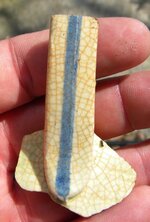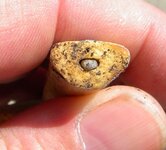Bramblefind
Silver Member
Any ideas what this was a part of? Crazing all over, surface with some unevenness and a small pin hole on one end. I thought maybe a smoking pipe stem? - but I have never seen one with such a curve. The handle of a cup?
I am taking a class about pottery and I will bring it in for my instructor to take a look at but wanted to try here too.


I am taking a class about pottery and I will bring it in for my instructor to take a look at but wanted to try here too.






 You can spend hours in it learning types of old pottery from precolonial to colonial to post colonial!
You can spend hours in it learning types of old pottery from precolonial to colonial to post colonial! 












